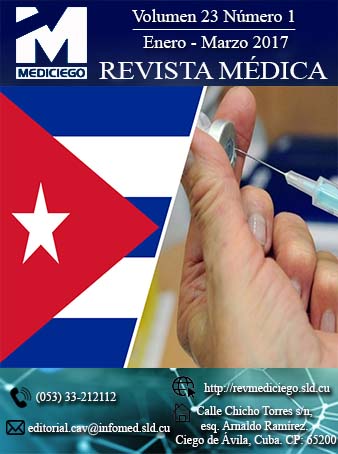Temporary behaviour of child mortality in Ciego de Avila during the 2000-2014 period
Abstract
Introduction: infant mortality is an international quality of life indicator that fully reflects a country's socio-economic landscape; it measures both care during pregnancy and childbirth as well as care for the child, their interrelation with the environment and the degree of socioeconomic and cultural development of the community.
Objective: to characterize the temporal behavior of infant mortality, according to selected variables, in the province of Ciego de Avila in 2000-2014.
Method: an observational ecological descriptive study of temporal series was carried out, whose universe of study covered all children under one year of age deceased and all live births in 2000-2014; this last figure was used to calculate the special rates of infant mortality.
Results: in general, there is a tendency in the province to decrease infant mortality. The annual correlogram showed a variety behavior with statistical significance in all its delays, suggesting a periodic cyclical behavior of the series; the highest oscillation identified in the periodogram was in the frequency of 0,5000, which corresponds to a period of two years, which means that every two years there is an increase in the infant mortality rate of the province.
Conclusions: with the exception of Baraguá municipality, in the rest of the province there is a steady trend or towards the reduction of infant mortality; the cyclical behavior of the indicator, with increments every two years, did not allow to corroborate the existence of seasonality in the series studied.Downloads
Published
How to Cite
Issue
Section
License
Copyright (c) 2021 Yerani Ferrer Martín, Lumey Venegas Ulloa, Pedro Ernesto Posada Fernández

This work is licensed under a Creative Commons Attribution 4.0 International License.
Those authors who have publications with this journal accept the following terms of the License CC Attribution-NonCommercial 4.0 International (CC BY-NC 4.0):
You are free to:
- Share — copy and redistribute the material in any medium or format for any purpose, even commercially.
- Adapt — remix, transform, and build upon the material for any purpose, even commercially.
The licensor cannot revoke these freedoms as long as you follow the license terms.
Under the following terms:
- Attribution — You must give appropriate credit , provide a link to the license, and indicate if changes were made . You may do so in any reasonable manner, but not in any way that suggests the licensor endorses you or your use
- No additional restrictions — You may not apply legal terms or technological measures that legally restrict others from doing anything the license permits.
The journal is not responsible for the opinions and concepts expressed in the works, which are the exclusive responsibility of the authors. The Editor, with the assistance of the Editorial Committee, reserves the right to suggest or request advisable or necessary modifications. Original scientific works are accepted for publication, as are the results of research of interest that have not been published or sent to another journal for the same purpose.
The mention of trademarks of specific equipment, instruments or materials is for identification purposes, and there is no promotional commitment in relation to them, neither by the authors nor by the editor.






















